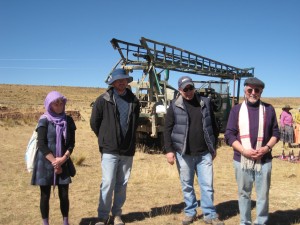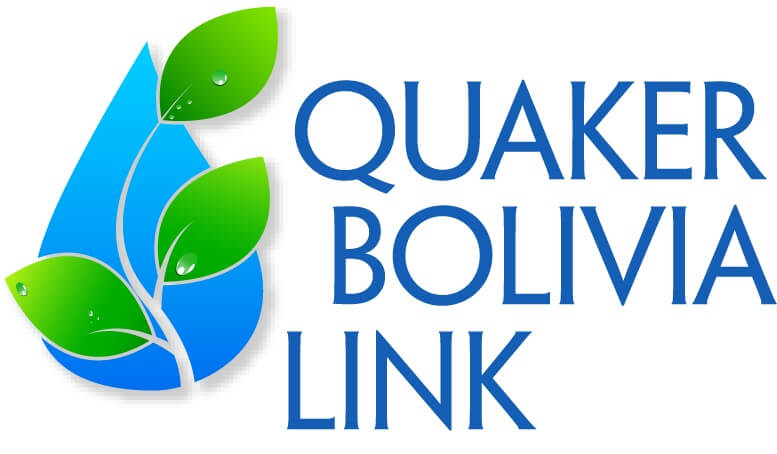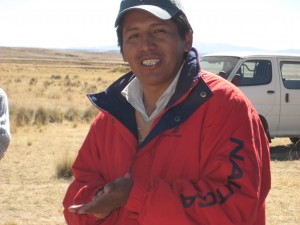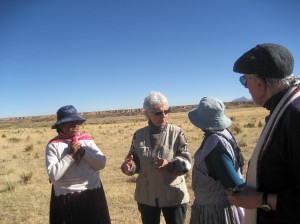This is a report on our exciting village wind pump project in Janko Saya—
I just received this email from Eloy Quiquisana, a member of our technical team in Bolivia:
Just to let you know that there is water in Janko Saya. Don’t worry. It’s good quality water too, with a flow rate of 1 liter/second.
Don’t forget the boots. And just in case, I wear size 38.
See you soon,
Eloy
I recently returned from visiting QBL projects in Bolivia with three US board members and one UK board member – who all paid their own expenses of course. We went with QBL agricultural technician Eloy to the Janko Saya project. It was the day after our first night in Coro Coro, a recently revitalized mining town almost four hours from La Paz. Even though we didn’t have heat, a shower or hot water, I think we all rested well that night. At least the little five-room hostel was clean, although the term “hostel” seemed an exaggeration.

UK Board member Joan, US Coordinator Robert, and US Board Members Steve and John, at Janko Saya. We are standing in front of the drilling rig.
We budgeted for a well of 60 meters, or almost 200 feet. We usually use gravity fed systems or hand pumps. Where wells are necessary they rarely need to be more than 10 meters deep. This was a big investment for QBL so we hoped that they would find good water.
This was the first time QBL has used wind power to pump water. If this is successful we will expand it to other communities. Electric pumps are good, but they increase the monthly cost of a water system from $0.15 to $1.65 per family. This has been too much of a burden in some communities.
We had to cross a river to get to the drilling site. On the rocks, you could see the white residues from the natural salts that made this water undrinkable, and unusable for the crops in Janko Saya. You can see why this is the highest priority project for us at QBL.
The village leaders were obvious in their colored outfits. This was my second community visit this year where a woman was dressed with some of the traditional Aymara trappings of a male leader. I hadn’t seen that before. These women were eloquent and forceful.
Ancient Aymara blessing ceremony
One of the leaders laid out a colorful woven cloth on the ground. He opened up his bag of coca leaves and placed a bottle of alcohol beside the leaves. He invited us to take a little coca to chew before he began the blessing. The coca leaf is not cocaine. No high. No addiction. An Andean tradition abused by the outside world.
On the Altiplano, there is still a strong reverence for the Mother Earth goddess Pachamama. If you violate the Earth by sinking a well then you need to make an offering beforehand. He took a few coca leaves and spread them along the ground. Next he poured drops of alcohol on each of the four corners of the cloth. Finally he sipped the alcohol, to complete his cha’lla, or blessing, and invited others to do the same.
Four people were chosen to carry the remaining coca leaves to burn over the drill site. I suggested that our board clerk John Scardina from New York City represent QBL. With solemnity and care, they took the paper holding the coca leaves to the small pyre and lit it. With that, they erupted into “hayaya’s,” the Aymara version of “hip hip hurrah.” We became quiet in this sacred space, conscious of the spiritual honor of being part of an ancient and living rite.
Eloy had always been certain that we would reach good water. Every time I said something like “hopefully we find water,” he would smile and say, “We WILL reach water Robert!” The people were hopeful and trusting, and I recognized how pessimistic I can be sometimes. I also knew that these people had a lot of work ahead of them. I’ve seen how much sweat it takes to dig the ditches for the pipes up there at almost 13,000 feet above sea level.
I know that there will be a lot of emotions over the next few months, both frustration and joy. I know that Eloy has much work ahead of him. He will provide technical assistance, guide the committee in making the purchases for the project, mediate disagreements and coordinate with the municipality for their funding. He will have to walk many miles as he inspects the ditches, the piping, the individual faucets, and encourage families as they finish the required work. He reminded me several times about how much he has to walk, and the toll it takes on his shoes. “… and just in case, I wear size 38.”
So, Eloy’s email brought me a welcome sigh of relief. Yes, they found water at 58 meters below the surface.
Eloy continued telling me about his need for good hiking boots for his work. He didn’t accept my suggestion that walking barefoot could be pretty healthy. My suggestion was seconded with a wry smile by a community leader.
After building over 50 village water systems, the Janko Saya wind powered project is new ground for us.
It is an exciting technology with huge potential in the Bolivian Andes.
QBL is in the vanguard.
Now I need to ask you to help us make a dream become reality for the people of Janko Saya. I need to ask you to open your check book or click this link and send us a donation.
Can you help us fund this project? The windmill will cost just under $3700, far less than it would be here in the US. That works out to only $150 per family. The cost of one follow-up visit by Eloy (in his new boots) comes to about $50. For $30 you can fund the installation of a faucet outside one of the houses.
You can change the lives of the people in one poor and remote Andean village—permanently.
ROBERT VINCENT
QBL Project Director
Oh yes, future projects will include a small amount to cover staff equipment—like that new pair of boots for Eloy.


